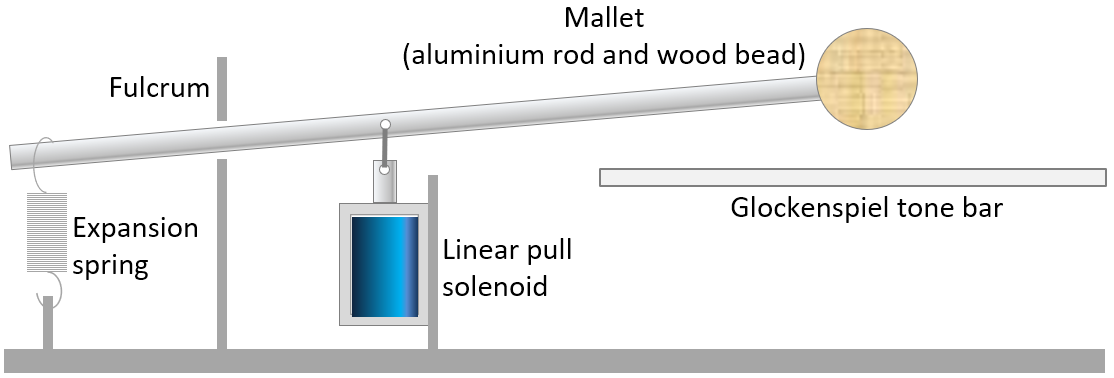While building the first EnsembleBot instrument, the tubular bells, work also began on the second percussive instrument, based on a cheap 27-note children’s glockenspiel. We were faced with a choice of how best to tackle this instrument.
Instrument status: Finished and working
HITTING THE BARS
There are several proven approaches to electromechanical glockenspiels (or similar). The simplest method involves linear push-solenoids directly hitting the metal bars either from above or below, one solenoid per bar. This is a very brute force approach, and it’s very hard to control the sound quality. Also, we didn’t have enough push-solenoids to spare for this instrument. So there.
At the opposite end of the spectrum are the very complex 3D articulated mallets, actually mimicking the way a human would play the instrument. While this solution is very intriguing indeed, it is beyond our skills and means to make the hardware.
Instead, we settled on something in-between. We use small, cheap linear pull-solenoids actuating custom made mallets. Here is a small demonstration of the glockenspiel, with the tubular bells chiming in:
The solenoids were sold as 5V micro-solenoids, but we found that when using short actuation times (<30 msec) we could easily use them at 10-12V without the risk of overheating. This provided a much stronger actuation, easily capable of swinging a short mallet, even though they really are very small.
It’s quite lucky that we bought so many of these micro-solenoids, as we did, because now they are nowhere to be found, unless you are willing to pay obscene prices. We paid about £0.70 (or a little more than $1) per solenoid with shipping in 2015. Recently (early 2018), I saw them on sale for £2.20 as the cheapest option. Weird.
CONSTRUCTION
As you can see in the images, the construction is extremely simple but very efficient. Everything but the solenoids are stuff you can buy at most DIY or hardware stores: Acrylic glass, aluminium profiles, aluminium rods, large wood beads, expansion springs and so on.
The mallets are based on 5 mm aluminium rods, wooden beads and a simple class 3 lever principle. There were no prior calculations or experiments – it just worked in the first attempt. Looking back at most of our designs, we are obviously blessed with either very good luck or a very good intuition.
There’s not much else to say about the construction, other than it works, it has proven very reliable, and the glockenspiel is a wonderful addition to the ansemble with its more than 2 octaves range. By varying the actuation time of the solenoids (the time where the driver sends current through the solenoid to move the mallet), you can actually introduce a fair amount of dynamics to the music.
SOLENOID DRIVER
These small solenoids don’t need much current, and we can build a simpler driver circuit for the glockenspiel. Sharing a prototyping PCB with the tubular bell driver, we based the driver on optocoupling of 2 x16 ports from the percussion circuit I/O expander.
The actual driver stage are 2 x 4 ULN2803 darlington arrays, piggybacked to better distribute heat. Because of the lower current demands, there was no need for large MOSFET drivers here.
The driver board is placed on the back side of the cabinet. Power from the driver is provided by a 34-way 28AWG ribbon cable up to the solenoids in the glockenspiel on top of the cabinet.
ENCLOSURE
The glockenspiel works rather well and has so far proven reliable. The only two problems are, that (1) it only works when placed horisontally, and (2) that it’s incredibly ugly to look at. To better project the sound out towards the audience, it could be nice to be able to tilt the instrument 30-45 degrees. This would also be a visual bonus, but the current construction doesn’t allow that – the solenoid/mallet setup would become unbalanced and stop working.
As an alternative solution I built a small wooden frame for the instrument, and use a tilted mirror above the glockenspiel, to both allow the audience to see the action of the mallets and to a certain degree direct some more sound outwards. For now, the mirror lid is raised manually, but it could be made motorized, so that the top of the instrument can be raised and lowered to play loud or muted.
Next: Read about the simple percussion instruments






